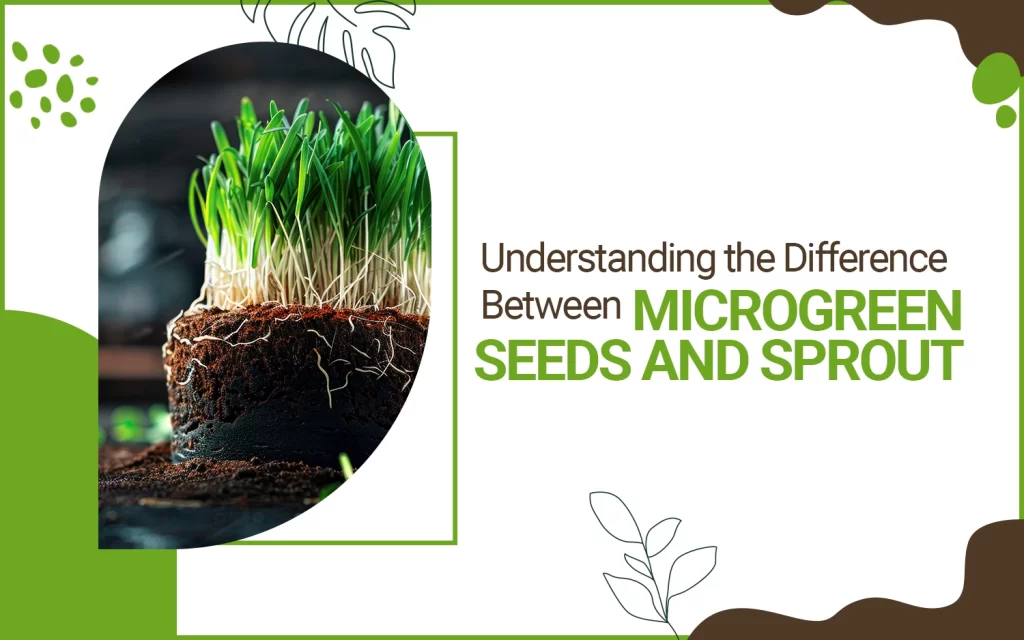
What most people find very confusing are the differences between microgreens seeds and sprouts. As a result of this widespread understanding, there is a wrong notion that microgreens are actually not the same as sprouts. They, in fact, differ in their appearance and flavor from one another and also have the added dimension of being grown in a manner distinct from one another.
It is important to note that microgreens differ from sprouts. Sprouts were germinated in water and not in soil for one or two days to produce leaves not yet fully formed. Microgreens require soil and sunshine to grow, and it takes at least a week for them to get leaves.
How they differ from one another; how one can do microgreens sprouting—from what is the best technique to assure you of good germination and growing these nutrient-dense greens, let’s get into it. Let’s have a look at the benefits of growing microgreens and how to add them to your daily meals for extra health benefits.
Sprouts are simply seeds that germinate into mature plants. It means that when the seed pops open, first the plant grows before any actual leaves show. Every seed bears growth in two dimensions at once. This all starts by soaking these seeds in water for 7 days. Starting from the root of a plant, then the radicle that searches for nutrients and water to grow.
Sprouts are rich in nutritional factors. They provide several benefits when consuming them in your daily diet. Generally speaking, nevertheless, the sprouting process raises nutrient levels, hence sprouts are richer in protein, folate, magnesium, phosphorous, manganese, and vitamins C and K than sprouting plants.
Growing sprouts at home is not that difficult and worth the little trouble. You will require a sprouts grow kit containing seeds to sprout, a sprouting jar, and a lid with mesh on it for an easy rinse.
Microgreens are young and tinier seedlings of edible vegetables. These little versions barely reach a few inches and come in 50 to 60 distinct colors. Because they are more expensive, microgreens were first only found on elegant dinner plates and in boutique grocery stores.
Nowadays microgreens are being used in more ways as they can be cultivated in homes as well.
There are different species of microgreen seeds with a range of flavors available at grocery stores. Some of the most popular among these greens are:
Radish microgreen seeds are known for their spicy flavor, which is similar to the taste of mature radish roots. They add a zesty kick to salads, sandwiches, and wraps. Radish microgreens are rich in vitamins A, B, C, E, and K, as well as minerals such as calcium, potassium, and magnesium. To grow radish microgreen, you can use radish seeds for sprouting specifically labeled for microgreen production.
You may wonder what does a radish sprout look like?
Well, radish sprouting seeds typically have two small leaves with a thin pale stem. As they continue to grow more leaves emerge and the stem becomes more thicker.
Broccoli microgreens are praised for their mild, slightly peppery flavor and crunchy texture. They are a good source of sulforaphane, a compound with potential health benefits. Broccoli microgreens are rich in vitamins A, C, and K, as well as dietary fiber and antioxidants. When growing broccoli microgreens, it’s essential to use seeds intended for microgreen cultivation to ensure optimal results.Organic broccoli seeds for sprouting are the best to cultivate when you are looking to grow in your home.
The flavor is nutty, and the texture is crunchy. They are actually an excellent supply of indispensable nutrition that includes protein, vitamin E, folate, and healthy fats. For the purpose of garnish, in salads, or topping different dishes, sunflower microgreens can be used. When looking to grow sunflower sprouting seeds, use only those marked for microgreen production to obtain maximum flavor and nutrition.
If you want to avoid mold on microgreen seeds, you need to consider ensuring appropriate air circulation and drainage. Here are a few tips:
With these tips, you will prevent any molds from developing on your microgreens.
Knowing the exact differences between microgreen seeds and sprouts is the most important factor in successful microgreen growing. With all the varieties of organic microgreen seeds available, each has its taste and nutritional value: radish, broccoli, and sunflower seeds. You can develop nutrient-rich microgreens at home, provided you have the right seeds and proper techniques or the ready-made ones are available just one click away.
Lilybel Microgreens brings the nutritional benefits of microgreens. We’re experts in growing a distinctive range of microgreens, perfect for enhancing the flavor and nutrition of your dishes.
© 2024, lilybel Microgreens, All Right Reserved by Design Sketchers.